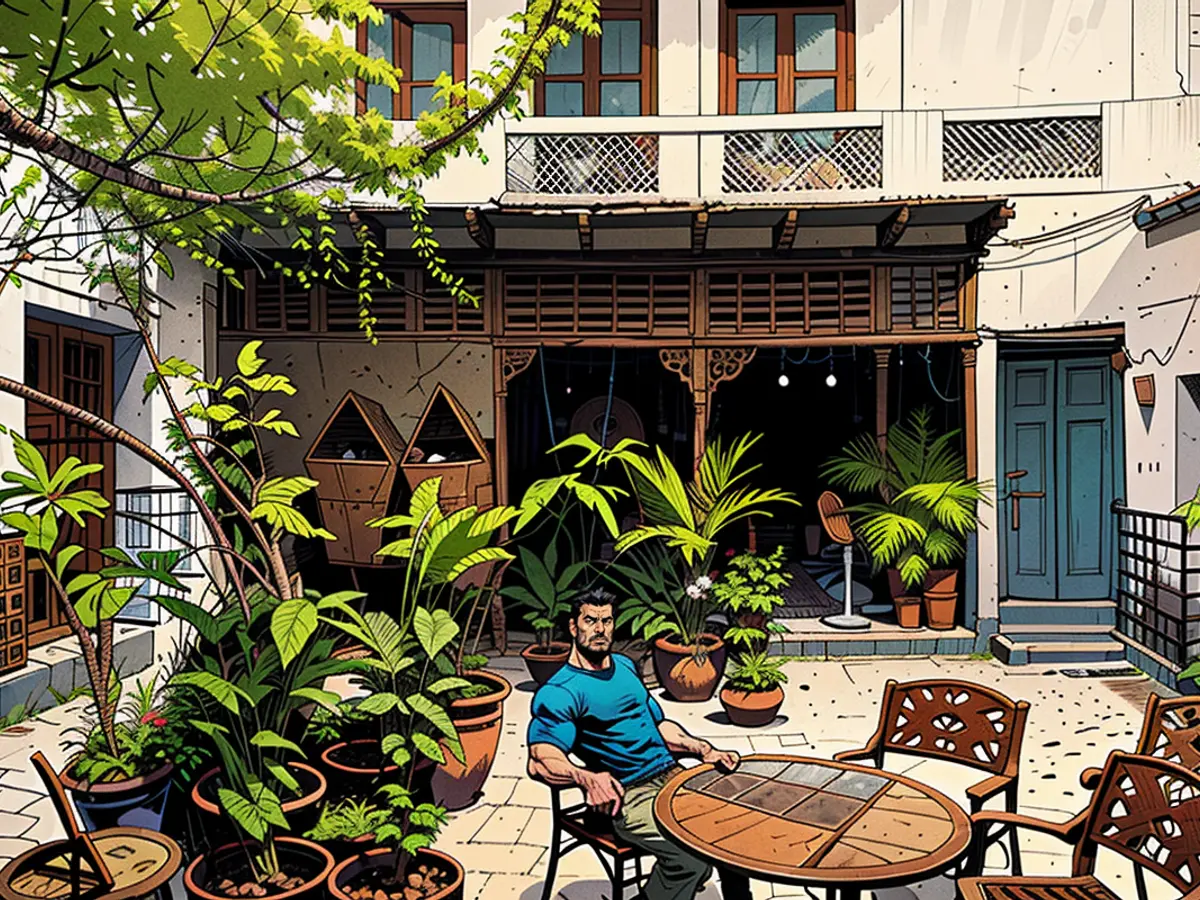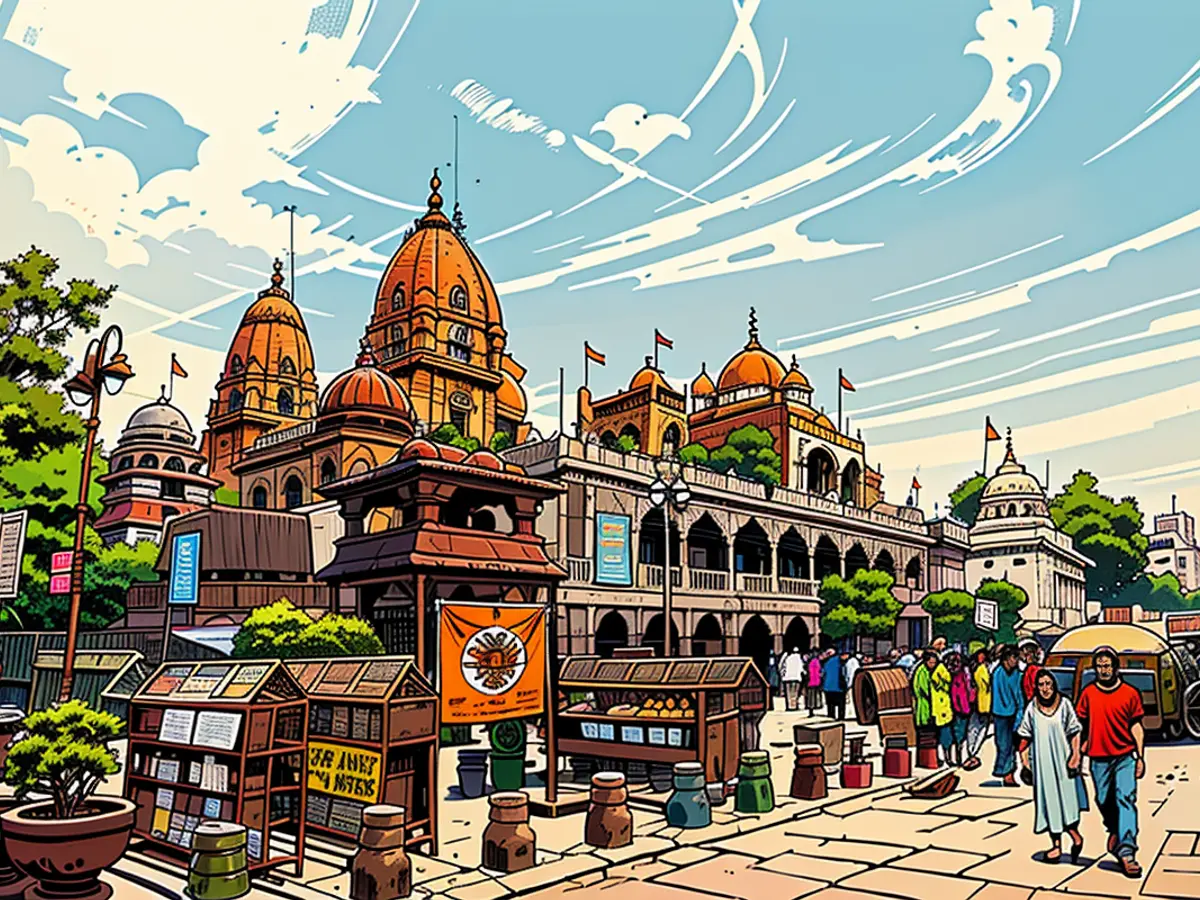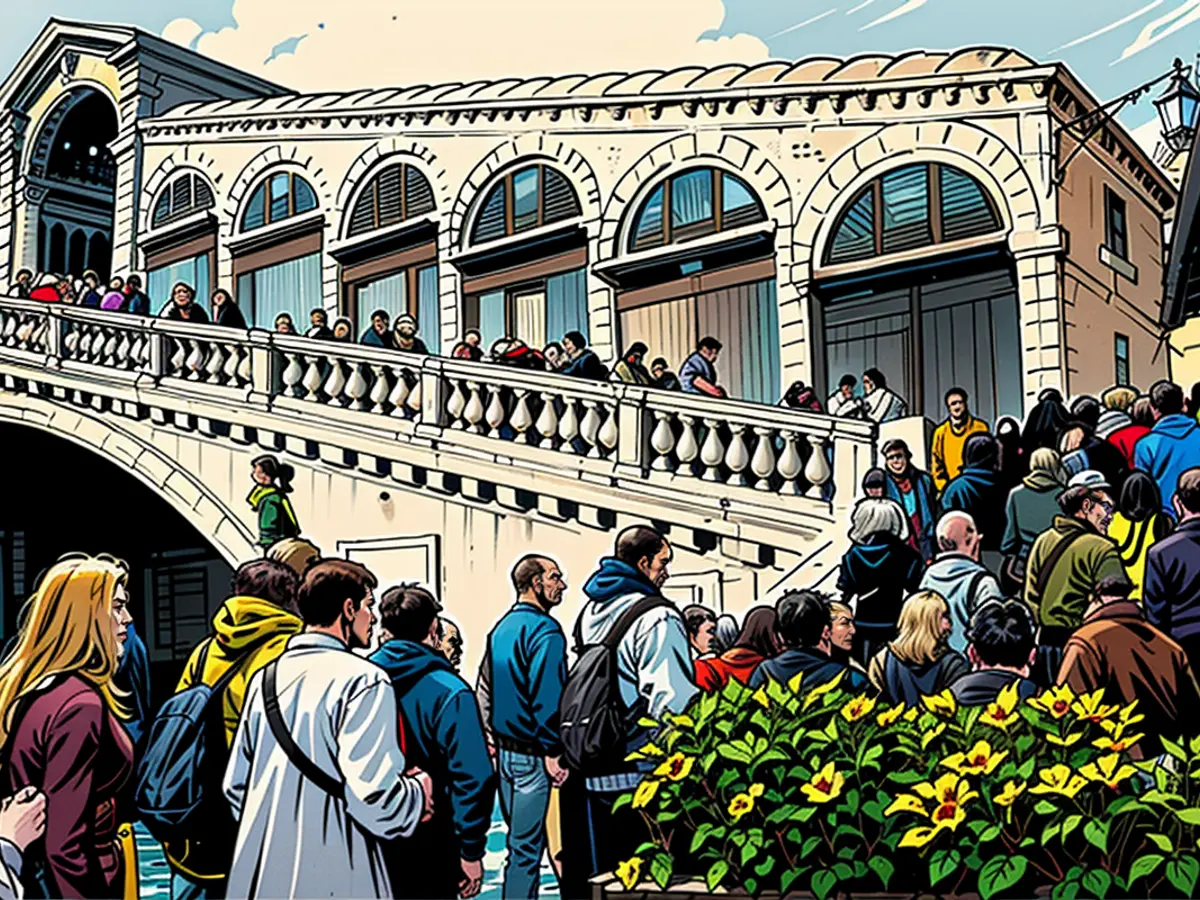Within a singular Delhi dwelling, an extensive chronicle of Indian history spanning several centuries unravels.
In its prime, Chandni Chowk was a neighborhood that sparked admiration and awe.
Established in the 17th century by Emperor Shah Jahan, it showcased the opulence of the once powerful Mughal empire, swiftly claiming a spot as one of India's most sought-after districts, where the privileged and influential dwelled in stylish mansions.
Nowadays, this section of the Old Delhi's ancient walled city offers a different atmosphere, alluring visitors to an energetic food street scene. While architectural vestiges of its former prosperity remain evident, the sumptuous residences of the wealthy have vanished, transforming into hotels or other commercial properties, with their previous inhabitants long gone.
However, Ajay Parshed, now 80-years-old, remains an exception.
A man of steadfast strength, Parshed occupies the courtyard of his sprawling 120-room ancestral mansion, nearly the solitary figure left among the relics of Chandni Chowk's original inhabitants, valiantly preserving the grandeur of a bygone era.
In his words, "It's the only living mansion on the historic Chandni Chowk street." Parshed descends from Chunna Mal, a moneylender and businessman who constructed the mansion back in 1864, as the silver plaque inside the home's hallway reveals.
Although Parshed clings to his ancestors' legacy, much of the allure of previous centuries has faded. The majority of the mansion's rooms stand abandoned and unused, with the antiques within gathering dust.
Of the 32 heirs of Chunna Mal, only Parshed and his family of ten still reside. Yet, he remains the sole advocate for maintaining the property.
"The family wishes to sell, but I oppose it," he admits. "I've striven to bring everyone together." Parshed hopes to prevent the mansion from being transformed into a hotel.
Parshed also shares stories of the splendor of the street, mentioning an octagonal pool that would mirror the moon's reflection in its waters. Hence the name Chandni Chowk: "Moonlit Crossing."
The Mughal Empire, which emerged in the 16th century and eventually controlled a significant portion of the Indian subcontinent before declining and disintegrating in 1857, contributed significantly to India's rich cultural and architectural inheritance.
In Delhi, these historical landmarks include Humayun's Tomb, Jama Masjid, and the Old Fort. The adjacent city of Agra was adorned with the Taj Mahal, an architectural marvel that attracts countless visitors daily, recognized as one of the seven wonders of the world.
Chandni Chowk also became part of Shah Jahan's new capital, Shahjahanabad – or Old Delhi, as it later became known.
Unfortunately, many sections of this street experienced destruction during the 1857 uprising, when residents revolted against British rule. The British suppressed the rebellion, thereby bringing an end to Mughal rule in Delhi and marking the beginning of the British Raj.
Yet, mansions like the one belonging to Chunna Mal's family remained untouched. "Chunna Mal supported the British," Parshed notes, "and as a result, we enjoyed numerous privileges."
Chunna Mal, he further reveals, was appointed Delhi's first municipal commissioner.

Today, Parshed's mansion represents a blend of the splendor of the 17th century and the changes that are shaping it or rendering it forgotten.
The Moonlit Crossing
The somber vastness within the spacious mansion contrasts strikingly with the bustling atmosphere of present-day Chandni Chowk Road outside.
The city's oldest street lies at the gateway of the Mughal-era Red Fort, where India's prime minister oversees the annual Independence Day flag hoisting ceremony, and extends 1,400 yards to the 17th century Fatehpuri Mosque.
A blend of businessmen, cycle rickshaws, and shoppers arriving to purchase clothing, jewelry, or savor the delectable street food crowd the area, drawing thousands of tourists and visitors daily.
For Rameen Khan, founder of City Tales, which organizes heritage walks and tours in and around Delhi, the importance of this road extends far beyond its physical offerings.
“This street embodies over three and a half centuries of India's history,” he says. "Its nooks and crannies preserve India's history, unnoticed and unappreciated, though they serve as a testament to the evolution of India’s past."
According to Khan, an octagonal pool that shimmered with the moon's reflection once adorned this spot, giving the neighborhood its name: Chandni Chowk, or "Moonlit Crossing."
“Given its grandeur,” Khan concludes, “it's only fitting that the entire street is named after it.”
Tying history and faith
It's not just the intricate tapestry of history that intertwines here in this sliver of Old Delhi. Multiple houses of worship coexist in Chandni Chowk: a Jain temple, a Hindu temple, a mosque, a Sikh shrine, and a Baptist church.
“This illustrates India's ability to peacefully coexist despite its numerous challenges,” Khan notes.
Sheetal Saxena, 23, a local housewife smiles, “The fact that this place welcomes anyone and everyone is what makes it truly representative of India.”
These religious centers are also tourist attractions, particularly the reddish-pink Digambar Jain Lal Temple, which is deeply revered by those adhering to the Indian religion Jainism, which emphasizes non-violence and a diet that excludes garic and onions.
Built in the 17th century, the temple underwent renovations in 1878 using red sandstone, earning it the nickname the Red Temple.

During a period of decline for the Mughal empire, a nobleman in its army constructed a temple dedicated to Shiva in the 1760s. As Khan notes, "You can see that other groups were gaining power then, and building a temple so close to the Mughal throne is a testament to that."
Across the street stands the Central Baptist Church, which dates back to the British colonial era. According to Khan, the original church was destroyed during the 1857 revolt and later rebuilt. Travelers looking for it can find inscriptions of prayers and commands written in Urdu on golden-colored slabs inside.
Another relic of the declining Mughal empire can be found in the Golden Mosque, where Nader Shah, the Persian emperor, ordered a plunder of Delhi in 1793.
Nearby, a Sikh shrine marks the spot where one of the 10 gurus who founded the faith was murdered. During the Mughal era, it was a police station. After the Mughals lost power, the Sikhs constructed their temple - called a gurudwara - on this site.
For Khan, these buildings serve as a reminder of the various eras that the neighborhood has experienced.
Moving towards the future
Locals attribute the recent increase in the popularity of Chandni Chowk to the local government's renovation of the area, which included banning all traffic except for rickshaws, constructing new red sandstone walkways, and planting more trees to create a pedestrian zone.
Some argue that there is still much work to be done, however. Dilip Saxena, a lifelong local retiree, points to the area beyond the main thoroughfare as being plagued by dirt, monsoon floods, and building fires. He believes the neighborhood's status as a residential area is being eroded.
"When I was growing up here, there were 13 homes in the area around my home. Now there are only two. People have sold off their property and turned it into commercial establishments, moving out," Saxena says.
One of those commercial establishments is a new mall located 100 yards away from Chandni Chowk.
"There's a concern that the old-world charm of this area may be forgotten or altered over time as generations go by," Saxena notes.
"Will they stop at the mall, or build many more? Who knows?" he asks.
For Ajay Parshed, this development is primarily for tourists, not for those who live in the area. "You can ban vehicles, but what about medical emergencies for us residents?"
Despite this, Parshed has no plans to leave. "This is the rich history of my family. I cannot even imagine leaving," he says.
In an attempt to preserve the past, Ajay Parshed refuses to sell his ancestral mansion, which stands as the only living testament to the grandeur of Chandni Chowk's historical past. The mansion, built in 1864, serves as a reminder of the opulent lifestyle once enjoyed by the privileged in this bustling neighborhood.
Chandni Chowk, famous for its energetic food street scene and rich cultural heritage, has seen significant changes over the years. Where once luxurious mansions like Parshed's sprawling 120-room ancestral home stood, hotels and commercial properties now take their place.
Despite these changes, Parshed remains determined to preserve what remains of Chandni Chowk's past, sharing stories of the street's splendor and its rich history with anyone who will listen. His mansion, located on historic Chandni Chowk Street, is a blend of the past and the present, offering a glimpse into a bygone era amidst the bustle of modern-day Delhi.

Read also:
- Fear of escalation in the Middle East: US Secretary of State Blinken travels to the region again
- Government circles: US Secretary of State Blinken to travel to Middle East again
- Bridging days 2024: How you can double your vacation this year
- Germany has wanderlust: how tour operators and airlines are looking ahead to the next travel year








